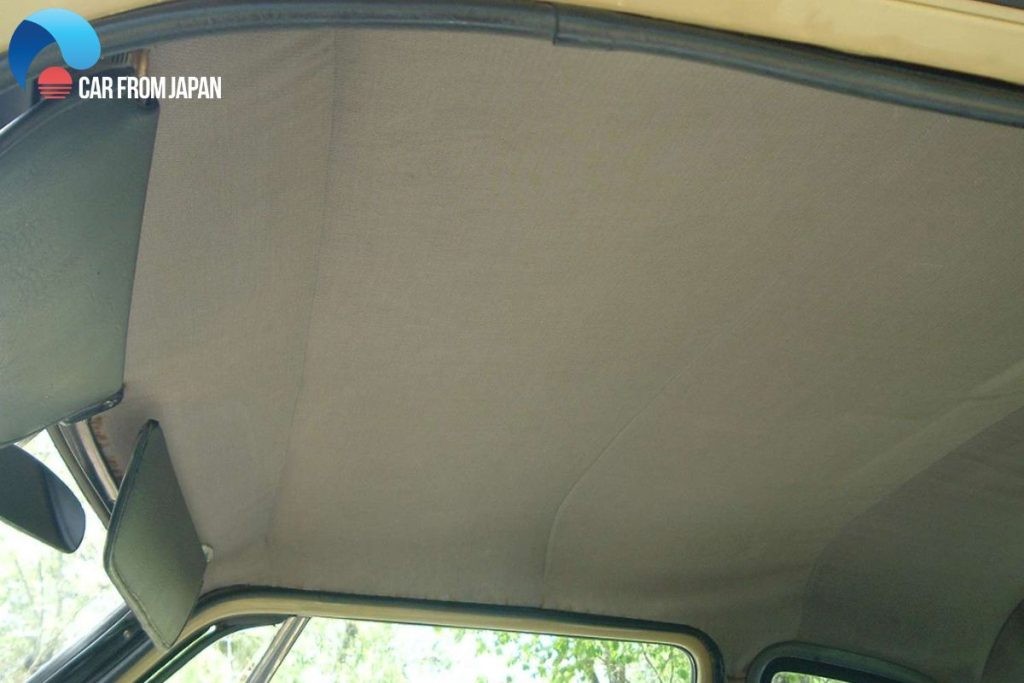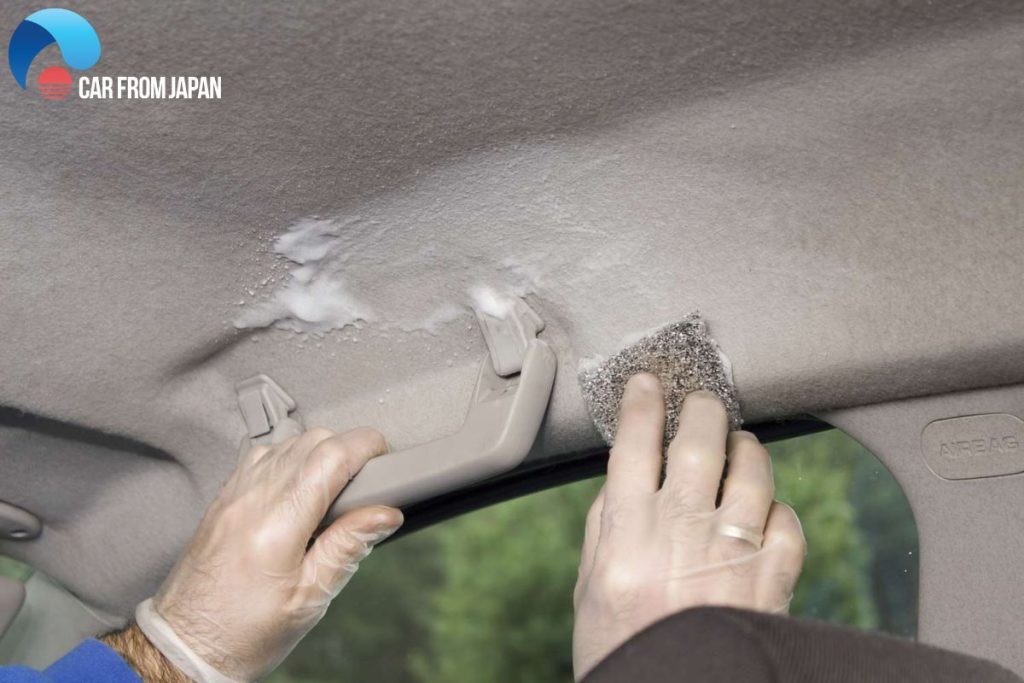A sagging car headliner is more than just an eyesore; it can detract from your driving experience and even indicate underlying issues within your vehicle. If you’re noticing the fabric above you drooping or detaching, you’re not alone. Many car owners face this problem, especially in older vehicles or those exposed to harsh climates. Fortunately, you don’t always need to resort to expensive replacements or complicated removals. This guide will walk you through effective methods on how to repair your auto headliner without taking it out, saving you time and money.
Understanding Your Car Headliner
Before diving into repairs, it’s helpful to understand what a car headliner actually is and its purpose. The headliner is the fabric material affixed to the interior roof of your car. It’s not just for aesthetics; it plays several crucial roles:
- Interior Comfort: It provides a smooth, finished look to your car’s interior, enhancing the overall cabin ambiance.
- Noise Reduction: The headliner acts as a sound absorber, minimizing road noise and vibrations for a quieter ride.
- Temperature Insulation: It insulates the cabin from extreme temperatures, helping to keep your car cooler in the summer and warmer in the winter.
Typically, a car headliner is constructed with multiple layers. This often includes a foam backing, commonly made of polyurethane, which is bonded to a rigid headliner board. This assembly is then attached to the car’s roof frame. This layered construction is what provides the headliner’s softness, insulation, and sound-dampening properties.
Common Causes of Auto Headliner Sagging
Over time, car headliners can begin to sag. This is usually due to the adhesive failing, causing the fabric to separate from the backing board. Several factors contribute to this deterioration:
- Heat and Sunlight: Extreme heat, especially from prolonged sun exposure, is a primary culprit. The heat weakens and breaks down the adhesive that bonds the fabric to the foam backing, leading to the fabric loosening and sagging.
- Moisture and Humidity: Moisture, whether from humidity or leaks, can be absorbed by the foam backing. This moisture can degrade the foam and adhesive, causing the headliner to lose its shape and sag. Leaks from sunroofs, windows, or even condensation can contribute to this issue.
- Age and Wear: Like any material, the components of a headliner degrade over time. The adhesive can simply lose its effectiveness due to age, especially in vehicles that experience temperature fluctuations.
- Poor Initial Installation: In some cases, a headliner may sag prematurely if it wasn’t properly installed at the factory or during a previous replacement. Insufficient adhesive or incorrect installation techniques can lead to early failure.
- Physical Stress: While less common, physical stress from passengers, especially children or pets pulling or scratching at the headliner, can also contribute to sagging over time.
DIY Methods to Repair Sagging Headliner Without Removal
Replacing the entire headliner can be a costly and time-consuming process, often disproportionate to the value of an older vehicle. Fortunately, there are several effective and budget-friendly methods to repair a sagging headliner without the need for complete removal. These techniques focus on re-adhering the existing fabric or securing it in place.
1. Headliner Adhesive Spray
Using a specialized headliner adhesive spray is a straightforward approach, particularly effective for localized sagging or edges that are coming loose. This method involves re-gluing the fabric back to the backing board.
Steps:
- Preparation: Gently peel back the sagging fabric as much as possible without tearing it. Clean the exposed backing board and the back of the fabric to remove any loose debris or old adhesive. A soft brush or vacuum cleaner can be helpful.
- Apply Adhesive: Shake the headliner adhesive spray can well. Apply an even coat of adhesive to both the backing board and the back of the fabric. Follow the manufacturer’s instructions regarding drying time, which usually involves letting the adhesive become tacky before reattaching.
- Reattach Fabric: Carefully align the fabric and press it firmly back onto the backing board. Work in small sections to ensure a smooth, wrinkle-free finish. Use a clean cloth or roller to apply even pressure and ensure good adhesion.
- Cure Time: Allow the adhesive to cure completely according to the product instructions before exposing the headliner to extreme temperatures or stress.
Tips:
- Use a high-quality headliner adhesive spray specifically designed for automotive headliners. General-purpose adhesives may not withstand temperature changes and could fail quickly.
- Work in a well-ventilated area when using spray adhesives.
- Avoid over-spraying adhesive onto areas you don’t intend to treat. Use masking tape to protect surrounding trim if needed.
2. Twist Pins for Headliner Repair
Twist pins, also known as saggy stoppers or clear-headed twist pins, are an inexpensive and simple mechanical solution for securing sagging headliners. They are particularly useful for more extensive sagging where adhesive alone may not be sufficient.
Steps:
- Identify Sagging Areas: Locate the areas where the headliner is sagging most prominently.
- Insert Twist Pins: Take a twist pin and gently push it through the sagging fabric and into the foam backing board behind it.
- Twist to Secure: Twist the pin head to secure the fabric against the backing board. The clear plastic heads of these pins are designed to be relatively inconspicuous once installed.
- Distribute Pins Evenly: Place pins strategically throughout the sagging area, spacing them evenly to lift and support the fabric. You can create patterns or follow the contours of the headliner for a more visually appealing result.
Tips:
- Choose clear-headed twist pins designed for headliner repair. These are less noticeable than colored or metal pins.
- Avoid over-tightening the pins, as this could damage the fabric or backing board.
- While effective, twist pins are a more visible repair than adhesive and may not be ideal for those seeking a seamless, factory-like finish.
3. Steam Cleaner and Paint Roller Method
For headliners sagging around the edges or with more widespread looseness, a steam cleaner combined with a paint roller can sometimes reactivate the original adhesive. This method uses heat and pressure to re-bond the fabric.
Steps:
- Steam Application: Using a car steam cleaner with an appropriate attachment, gently apply steam to the sagging headliner fabric. Move the steam cleaner slowly and evenly over the affected areas. The steam’s heat will help to soften and reactivate the old adhesive.
- Rolling and Smoothing: Immediately after steaming an area, use a clean paint roller to gently roll and press the fabric back against the backing board. Apply even pressure to ensure good contact and adhesion as the adhesive cools.
- Work in Sections: Work in small sections, steaming and rolling one area at a time until the entire sagging section is addressed.
- Drying Time: Allow the headliner to dry completely. Avoid touching or disturbing the repaired areas until they are fully dry.
Tips:
- Use a car-specific steam cleaner with adjustable steam settings. Start with a low steam setting and gradually increase if needed to avoid damaging the fabric.
- Be cautious not to saturate the headliner with too much steam, as excessive moisture can worsen the sagging or damage the materials.
- Use a soft, clean paint roller to avoid damaging the headliner fabric.
- This method is most effective when the original adhesive is still partially intact and can be reactivated by heat.
Preventing Future Headliner Sagging
While repairs can restore your headliner, preventing sagging in the first place is ideal. Here are some preventative measures:
- Park in Shade: Whenever possible, park your vehicle in shaded areas or garages to minimize exposure to direct sunlight and heat. This will help protect the adhesive and fabric from degradation.
- Regular Interior Cleaning: Keep your car’s interior clean and dry. Address any leaks promptly to prevent moisture buildup in the headliner.
- Avoid Extreme Temperatures: Try to minimize prolonged exposure to extreme heat or cold, which can stress the headliner materials.
- Gentle Handling: Instruct passengers, especially children and pets, to avoid pulling or scratching at the headliner.
- Regular Seal Checks: Inspect your car’s weather seals around windows and sunroofs regularly to ensure they are in good condition and prevent water leaks.
- Avoid Harsh Cleaning Products: When cleaning your car’s interior, use mild, automotive-specific cleaners and avoid harsh chemicals that could damage the headliner fabric or adhesive.
When to Consider Professional Headliner Replacement
While DIY repairs are often successful, there are situations where professional headliner replacement may be necessary:
- Extensive Damage: If the headliner fabric is severely torn, stained, or deteriorated beyond repair, replacement is usually the best option.
- Widespread Sagging: If the sagging is extremely widespread and severe, DIY methods may be less effective and provide only temporary solutions.
- Complex Headliner Design: Some vehicles have complex headliner designs with integrated electronics or multiple sections. Replacing these may require specialized tools and expertise best left to professionals.
- Desired Factory Finish: If you desire a perfect, factory-fresh finish, professional replacement is the most reliable way to achieve this.
Headliner Replacement Costs
The cost of professional headliner replacement varies depending on factors such as vehicle make and model, headliner material, and labor rates.
| Vehicle Type | Estimated Replacement Cost |
|---|---|
| Simple Sedan/Hatchback/Coupe | $300 – $750 |
| Typical SUV/Crossover (with Sunroof/Moonroof) | $500 – $900 |
| Luxury Vehicle | $1,000 – $6,000+ |


These are approximate ranges, and actual costs can vary. Obtaining quotes from local auto upholstery shops or repair facilities is recommended for accurate pricing.
Conclusion
A sagging auto headliner can be frustrating, but it doesn’t always necessitate a costly and complex replacement. By understanding the causes of sagging and utilizing DIY repair methods like adhesive spray, twist pins, or the steam cleaner technique, you can often restore your headliner’s appearance and function without removal. Regular preventative maintenance and prompt attention to minor sagging can further extend the life of your car’s headliner, ensuring a more comfortable and aesthetically pleasing driving experience.
FAQs About Auto Headliner Repair
How do I know if my car ceiling is sagging?
Signs of a sagging car headliner include:
- Visible drooping of the fabric away from the roof.
- Loose or detached fabric, particularly around edges or corners.
- A “bubbling” or uneven appearance of the headliner surface.
- In severe cases, the fabric may hang down and obstruct vision.
Is it okay to fix the headliner sagging myself?
Yes, for many cases of sagging, DIY repair is a viable and cost-effective option. The methods described in this guide are designed for DIYers and can provide good results for minor to moderate sagging. Headliner repair kits are also readily available online and at auto parts stores.
Can I paint a car headliner?
While technically possible, painting a headliner is generally not recommended. Paint can make the fabric stiff, alter its texture, and may not adhere well over time due to temperature fluctuations in the car interior. The effort and potential mess of painting are often not worth the limited benefit, and proper fabric repair or replacement is usually a better solution.
Will car insurance cover headliner replacement?
Standard auto insurance policies typically do not cover headliner replacement due to wear and tear or sagging. Headliner issues are generally considered maintenance or cosmetic items. However, if headliner damage is caused by a covered event, such as vandalism or a collision, it might be covered under comprehensive or collision insurance, depending on your specific policy and circumstances. Check with your insurance provider for clarification.
